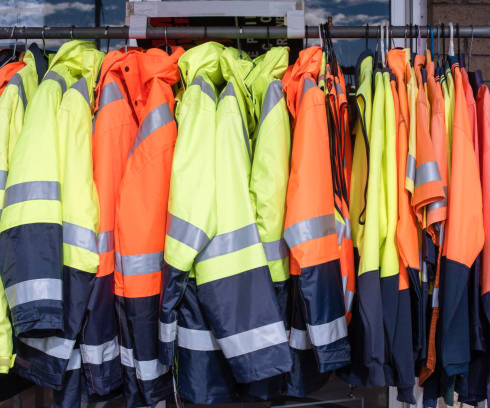Chemical
Gloves
UK industry spends more than £30m a year buying chemical protective gloves to use as PPE.
Chemical gloves are available in a variety of materials, however there is no single glove material able to provide unlimited resistance to any individual or combination of chemicals – so understanding the protection offered by your chemical gloves is vital.

Seek Expert Advice
When choosing gloves, always seek expert help from the distributor – that’s us! We can help give you glove performance test data which can be used to assist in predicting the permeation, penetration, and degradation of specific glove materials by specific chemical agents.

What is a chemical agent?
All liquids, solids, gases, vapours, aerosols, fumes, dusts, and fibres are classified as chemical agents – they are called chemical agents to distinguish them from biological agents (such as micro-organisms) and physical contaminants, such as noise, vibration, and friction.
Did you know…
0
People Sensitised to Chemicals
Up to 5 million people in Europe are already sensitised to chemicals present in textile and leather articles.
0
Sensitisation Cases Each Year
Up to 180 000 new sensitisation cases occur each year.
0
Chemicals & Chemical Mixtures
There are more than 350000 chemicals and chemical mixtures in the world, registered for commercial production and use.
Source: ECHA European Chemical Agency
Standards & Markings
EN ISO 374 is the main safety standard that applies to work gloves that protect against chemicals and micro-organisms. It consists of an array of standards, which has been updated on various occasions in recent years.
The main two standards for determining the chemical resistance of a glove’s material are:
EN ISO 374-1:2016+A1:2018 Protective gloves against chemicals and EN ISO 374-4: 2019 degradation testing of gloves. Chemical resistant gloves that have been certified to these standards have been tested for their resistance to permeation and degradation by specific hazardous chemicals.
The standard EN ISO 374-5: 2016 – Protective gloves against micro-organisms
The standard for gloves that protect against bacteria, fungi and viruses is tested to EN ISO 374-5: 2016.
Gloves must pass the penetration resistance test in accordance with standard EN 374-2:2014 – Determination of resistance to penetration. The possibility of claiming protection against viruses was added, if the glove passes ISO 16604: 2004 (method B) test.

Type C gloves are based on performance in tests against permeation by a certain number of chemicals.
Permeation is the process by which a chemical move through a glove’s material on a molecular level. In relation to Single Use gloves this would in most instances be: Nitrile, Latex or Vinyl. The permeation test measures breakthrough time (the time it takes for the chemical to move through the layers of the glove material).
Degradation is the change in the physical characteristics of a glove caused by contact with a chemical. Signs of degradation can include colour change, disintegration, flaking, hardening or swelling impacting the gloves protection levels.
Classification type |
Minimum performance level required to pass the test |
Minimum no. of chemicals against which protection is provided |
| Type A | 2 (min. 30 minutes to breakthrough) | 6 |
| Type B | 2 (min. 30 minutes to breakthrough) | 3 |
| Type C | 1 (min. 10 minutes to breakthrough) | 1 |
There are six performance levels:
Performance
|
Minimum
|
| 1 | > 10 minutes |
| 2 | > 30 minutes |
| 3 | > 60 minutes |
| 4 | > 120 minutes |
| 5 | > 240 minutes |
| 6 | > 480 minutes |
Under EN ISO 374-1: 2016, three samples from the palm of the glove (and, for gloves that are 400mm or longer, three samples from the cuff as well as the palm samples) are tested for permeation and degradation by a certain, minimum, number of chemicals from the following list of 18 substances:
Chemical |
Typically used in/for |
Code letter |
| Methanol | Paint manufacturing; fuel-cell manufacturing; organic chemical production; wastewater and sewage treatment; food and beverage processing; anti-freeze and de-icing products | A |
| Acetone | Organic chemical production; chemicals transport; paint and varnish manufacturing; pharmaceuticals manufacturing; beauty treatments | B |
| Acetonitrile | Pharmaceutical manufacturing; photographic film production; refineries; battery manufacturing | C |
| Dichloromethane | Chemical processing; food and beverage processing; garment printing; civil engineering; welding plastics | D |
| Carbon disulphide | Synthetic-fibre manufacturing; cellophane-film production; fruit and cereals production (for fumigation/as an insecticide) | E |
| Toluene | Fuels production (as an octane booster); a common solvent used in e.g. paint, paint thinners, adhesives and lacquers | F |
| Diethylamine | Corrosion inhibitor; as a (non-pesticide) agricultural chemical for crops; in flotation agents | G |
| Tetrahydrofuran | Solvent used in synthetic-fibre manufacturing | H |
| Ethyl acetate | Solvent used in food and beverage industry (to decaffeinate tea leaves and coffee beans; wine production); beauty products (perfume) and treatments | I |
| n-Heptane | A key component of petrol; solvent; paint and coatings manufacturing | J |
| Sodium hydroxide 40% | (also known as lye or caustic soda) Pulp and paper manufacturing; textile manufacturing; soaps and detergents; cleaning products | K |
| Sulphuric acid 96% | Fertiliser manufacturing; oil refining; wastewater processing; chemical synthesis; cleaning agent | L |
| Nitric acid 65% | Fertiliser production; explosives manufacturing | M |
| Acetic acid 99% | Textile printing; dye manufacturing; pharmaceuticals production; pesticides; cleaning agent | N |
| Ammonium hydroxide 25% | Adhesives; animal feed; cleaning and detergent products | O |
| Hydrogen peroxide 30% | Oxidiser; bleaching agent; disinfectant | P |
| Hydrofluoric acid 60% | Chemicals and pharmaceuticals manufacturing; used to etch glass and ‘wafers’ in the semiconductor industry | S |
| Formaldehyde | Industrial resin and coatings production; textiles processing | T |
The results of the degradation test must appear in the information leaflet.
The EN 388:2016 standard gives an indication of which gloves have the appropriate level of protection against the mechanical risks you will encounter in your working environment. Identifying the most appropriate type of gloves to use for a particular task can be achieved by conducting a risk assessment, where you examine the hazards present in the workplace and identify what protection each worker will need in order to safely perform the task.
Compliance to this standard requires characteristics of the glove, such as abrasion resistance, cut resistance, tear strength, puncture resistance and impact protection are tested and rated accordingly. In conjunction with the EN 388:2016 pictogram below, four numbers and one, or three numbers and two letters, will be displayed. These numbers and letters along with the EN388:2016 shield indicate the performance levels of the glove.
Abrasion Resistance
The glove materials is subjected to abrasion by a sample of sandpaper under a determined level of pressure. The protection level is indicated on a scale of 1 to 4 depending on the number of turns required for a hole to appear in the material. The higher the number, the better the resistance to abrasion.
Cut Resistance – Coup Test
In this test a knife is passed over a sample of glove material until it cuts through. The cut protection level is rated by a number between 1 and 5, where 5 indicates the highest cut protection. If the material dulls the knife during this test, the cut test ISO 13997(TDM test) will be performed instead giving a truer cut performance rating. In order to avoid confusion and to reduce cost on a test that is largely no longer considered, in many instances when releasing to market new gloves are not tested under Coup Test and so an X is used to replace the 1 – 5 score to indicate no Coup Test rating.
Tearing Strength
The force required to tear the glove material apart is measured. The protection level or tear strength is indicated by a number between 1 and 4, and as with the Abrasion test 4 indicates the strongest glove material.
Puncture Resistance
This test determines the amount of force required to puncture the material with a tip. The protection function is indicated by a number between 1 and 4, and as with the Abrasion and Tear tests 4 indicates the strongest glove material.
Cut Resistance – TDM Test ISO 13997
If, as mentioned in the Coup Test explanation above, the knife used in the Coup Test gets dull, the TDM Test ISO 13997 shall be performed instead. The result is given by a letter, A to F, where F indicates the highest level of protection. If any of these letters is given, this method determines the protection level instead of the coup test. If an X is displayed instead of an A-F this test was not performed.
ISO 13997:1999 – Determination of resistance to cutting by sharp objects
An alternative cut test recommended for determining the cut protection offered by a glove. Shall be used in EN388:2016 for cut protection gloves where the cut material dulls the cutting knife during Coup testing. A knife cuts with constant speed but increasing force until breakthrough of the cut protection material. Level of protection is given in Newton, the force needed for cut through at 20mm cut length. (Highest performance level F = 30 Newtons) See below performance levels assigned to each letter with some suggested applications and Industries.
Impact Protection
If the glove offers an impact protection, this information is given by the letter P as the 6th and last character. If no P is shown, no impact protection is claimed.
Defintions & Requirements
The nature of protection is shown by a pictogram relating to the specific protective qualities.
 Radioactive Contamination
Radioactive Contamination
To protect from radioactive contamination, the glove must be liquid proof and needs to pass the penetration test defined in EN374. For gloves used in containment enclosures, the glove shall pass an additional specific air pressure leak test. Materials may be mottled by their behaviour to ozone cracking. This test is optional and can be used as an aid to select gloves.
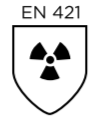 Ionising Radiation
Ionising Radiation
To protect from ionising radiation, the glove must contain a certain amount of lead or equivalent metal, quoted as lead equivalence. This lead equivalence must be marked on each glove.
The ISO 18889:2019 standard was established for gloves worn by operators when applying, handling, loading or mixing pesticides, as well as Re-Entry workers (a worker that could come into contact with partially or fully dried pesticide product as part of their work/employment in a previously treated area). This standard was published in April 2019 and was created to simplify the choice of PPE required to protect against pesticdes.
The gloves selected should pass the penetration test EN374-2:2014 – Determination of resistance to penetration However this is not required for GR gloves (chemical gloves permitted for use by Re-Entry workers only which only offer coating protection to the palm and fingertips) where it has been determined that protection of the fingertips and palm is adequate.
Glove length should be at least 240mm for G1 and 290mm for G2. Stipulation on glove length is not required for GR gloves.
Compliance to EN ISO 374-1:2016+A1:2018 Protective gloves against chemicals
- At Least Type C for G1 gloves (For contact with diluted pesticides – Low chemical risk)
- At least Type B for G2 gloves (For contact with diluted or concentrated pesticides – Higher chemical risk)
- A breakthrough time of >30 minutes against Sodium Hydroxide 40% for GR gloves
In addition, the cumulative permeation in the glove is also measured according to ISO 19918:2017 – (Protective clothing — Protection against chemicals — Measurement of cumulative permeation of chemicals with low vapour pressure through materials) as it has been established that EN16523-1:2015 (Determination of resistance to permeation by liquid chemicals) cannot be used for pesticides due to the specific properties of their inner chemical components which usually cannot be detected via this test method. The tested chemical is a dye surrogate and samples will be taken from parts of the glove.
- 3 Samples will be taken from the palm area, if seams are present samples will be taken from the seam area.
- If the glove is longer than 400mm, 3 extra samples will be needed. These will be taken from the centre of the glove and 80mm from the end of the cuff.
The below diagram details the compliance results for cumulative permeation for G1 (Lower risk), G2 (Higher Risk) and GR (Re-Entry) gloves.
Shop Sustainably♻️
When shopping for our chemical gloves, you’ll find a range of products marked as Good for People, Good for Community, or Good for Planet. These icons represent that these products meet our Sustainable Selection criteria, and can be used as an indicator to ensure you’re shopping for a more socially responsible safety option.
Our Safety Brands







Nitrile Coated Chemical Gloves
Nitrile Chemical Gloves offer a robust barrier that provides a good level of resistance against old, grease, and some chemicals. Nitrile Chemical Gloves are used in a range of industries, including; Automotive, Construction, Warehousing, Manufacturing, Food Production, and Industrial Cleaning.
An embossed pattern is often applied to the finished coating on the palm of the glove to further enhance grip. Some manufacturers add a flock lining to the gloves interior to make the glove more comfortable for the wearer as it aids donning and doffing.
Nitrile Chemical Gloves can be flexible and tactile and combined with nitriles other features including the wide variety of chemical agents it will protect against, makes Nitrile Chemical Gloves a highly popular choice when Chemical protective gloves are required. However, some wearers may be or can develop an allergic reaction to Nitrile. That said, it is far less common than people with an allergy to latex.
Nitrile gloves offer good resistance to solvents, grease, certain acids and oils. It is also a great choice when working with:
- Aniline
- Asphalt
- Benzylic alcohol
- Brake fluid
- Cutting oil
- Cyclohexane
- Fertilizers
- Gasoline
- Household detergents
- Mineral oil
- Naphtha
- Xylene
However, nitrile gloves are not suitable for use with all types of chemicals. They fail to protect against chemicals such as aromatic solvents, concentrated acids, and highly corrosive chemicals, therefore alternative chemical gloves will be required for applications involving these types of chemical agents.
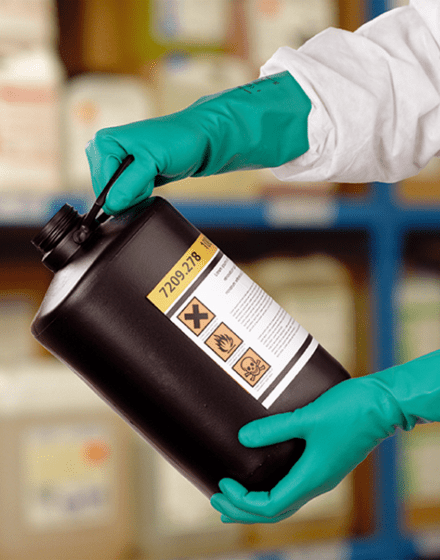
Latex Coated Chemical Gloves
Latex is a versatile material that provides a good amount of elasticity – making Latex chemical gloves a popular choice, particularly in laboratories, agriculture, food production and the pharmaceutical industry. The elasticity also allows for greater dexterity and flexibility.
With elasticity comes the ability to get a tight fit and as such, the interior of the glove is sometimes covered with a powder that makes the glove easier to Don and Doff.
Latex is often a less expensive alternative to Nitrile, however, as with all chemical applications, EN 374 performance is the real indicator as to whether Latex Chemical Gloves are suitable for choice.
Latex chemical gloves offer protection against many biological and chemical agents, including:
- Acetone
- Formaldehyde
- Hydrochloric acid
- Methanol
- Nitric Acid
- Phosphoric acid
- Potassium hydroxide
- Sodium hydroxide
- Sulfuric acid
However, latex can cause some wearers to have an allergic reaction. Therefore, they are not suitable for all employees requiring chemical gloves.
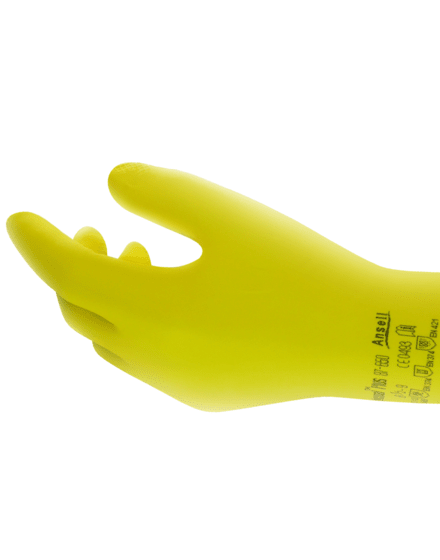
PVC Coated Chemical Gloves
Polyvinyl Chloride, known as PVC, is a material often used in the manufacture of chemical resistant gloves. PVC Gloves provide a good level of protection against acids, bases, amines, peroxides, and fats.
As is the case with all chemical gloves, the protection offered against the chemical or chemicals, in accordance with all parts of EN 374, will determine the suitability of the glove.
PVC also protects against these other substances:
- Ammonium Hydroxide
- Benzylic alcohol
- Boric Acid
- Chromic Acid
- Creosote
- Diluted Sulphuric Acid
- Ethylene Glycol
- Fluorides
- Methanal
- Phosphoric Acid
- Silicates
- Sodium Hypochlorite
PVC, however, does not perform well against various organic solvents. It also has poor heat resistance, which makes it unusable in high-heat environments.
Most PVC gloves stay flexible even in cold environments. It offers relatively high puncture resistance and provides a great grip. PVC Chemical Gloves have their uses in industries, such as:
- Commercial Fishing
- Construction
- Mining
- Petrochemical
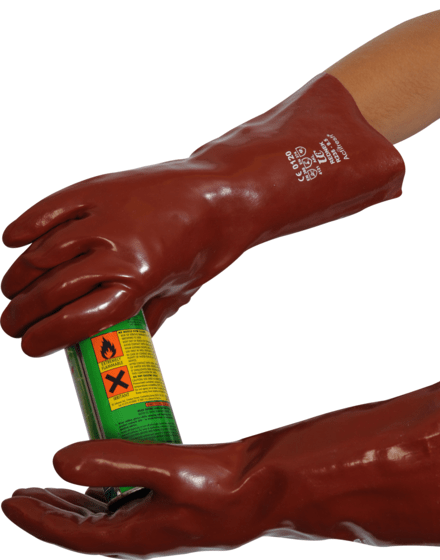
Staysafe PPE
Laundering
Staysafe laundering can break down the cell walls of bacteria, pathogens, and viruses. Around 80% of gloves and PPE sent to Staysafe are suitable for re-issue, saving 14.7 tonnes of CO2e for every tonne of re-used PPE.
